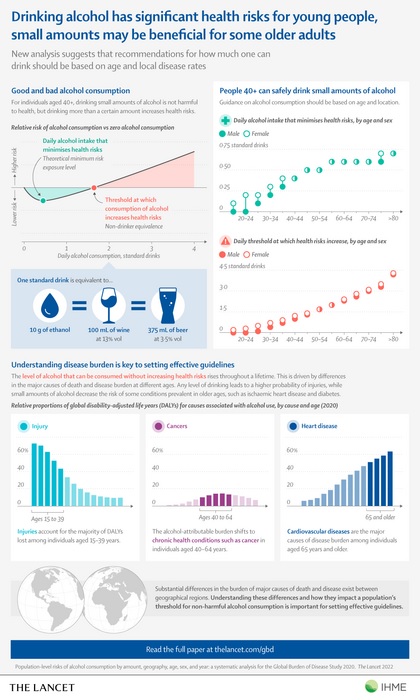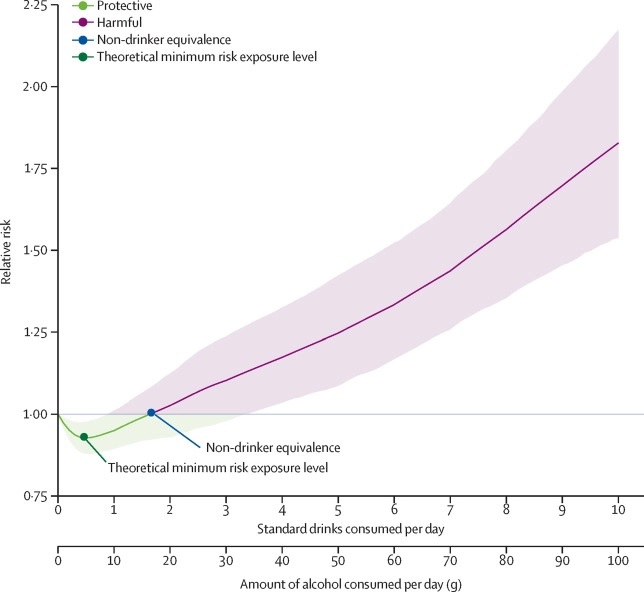Summary Background The health risks associated with moderate alcohol consumption continue to be debated. Small amounts of alcohol may reduce the risk of some health outcomes but increase the risk of others, suggesting that overall risk depends, in part, on background disease rates, which vary by region, age, sex and year. Methods For this analysis, we constructed load-weighted dose-response relative risk curves across 22 health outcomes to estimate the theoretical minimum risk exposure level (TMREL) and non-drinker equivalence (NDE), the drinking level. in which the health risk is equivalent to that of a non-drinker , using disease rates from the 2020 Global Burden of Diseases, Injuries and Risk Factors (GBD) Study for 21 regions, including 204 countries and territories, by age group of 5 years, sex and year for individuals aged 15 to 95 years or older from 1990 to 2020. Based on the NDE, we quantify the population that consumes harmful amounts of alcohol. Results Load-weighted relative risk curves for alcohol consumption varied by region and age. Among people ages 15 to 39 in 2020, the TMREL ranged from 0 (95% uncertainty interval 0–0) to 0.603 (0.400–1.00) standard drinks per day, and the NDE ranged from 0.002 (0–1.00) standard drinks per day. 0) and 1.75 (0.698-4.30) standard drinks per day. Among people aged 40 years and older, the burden-weighted relative risk curve was J-shaped for all regions, with a 2020 TMREL ranging from 0.114 (0–0.403) to 1.87 (0.500–3·3). 30) standard drinks per day and an NDE ranging from 0·193 (0–0·900) to 6·94 (3·40–8·30) standard drinks per day.
Interpretation There is strong evidence to support alcohol consumption recommendations that vary by age and location. More robust interventions, particularly those designed for younger people, are needed to reduce the substantial global health loss attributable to alcohol. Funding: Bill and Melinda Gates Foundation. |

Figure: Drinking alcohol has significant health risks for young people; Small amounts may be beneficial for some older adults. A new analysis suggests that recommendations for how much you can drink should be based on age and local disease rates.
Comments
New analysis from Global Burden of Disease estimates that 1.34 billion people consumed harmful amounts of alcohol (1.03 billion men and 0.312 million women) in 2020.
The analysis suggests that for young adults aged 15 to 39, there are no health benefits to drinking alcohol, only health risks, with 59.1% of people consuming dangerous amounts of alcohol in 2020 between the ages of 15 to 39 years old and 76.7% men.
The authors note that given the complex relationship between alcohol and disease and the different rates of history of disease around the world, the risks of alcohol consumption differ by age and geographic location.
For adults over 40, health risks from alcohol consumption vary by age and region. Consuming a small amount of alcohol (for example, drinking one to two 3.4-ounce glasses of red wine) for people in this age group may provide some health benefits, such as reducing the risk of cardiovascular disease, stroke, and diabetes .
The authors call for alcohol consumption guidelines to be revised to emphasize drinking levels by age, emphasizing that the level of alcohol consumption recommended by many existing guidelines is too high for young people in all regions. They also call for policies aimed at men under 40, who are more likely to use alcohol in harmful ways.
Young people face greater health risks from alcohol consumption than older adults, according to a new analysis published in The Lancet . This is the first study to report alcohol risk by geographic region, age, sex, and year. It suggests that global alcohol consumption recommendations should be based on age and location, with the strictest guidelines targeting men aged 15 to 39, who are at the highest risk of harmful alcohol use worldwide.
Research also indicates that adults ages 40 and older without underlying health conditions may see some benefits from drinking alcohol in small amounts (between one and two standard drinks per day [1]), including a reduced risk of cardiovascular disease, stroke and diabetes.
Using estimates of alcohol consumption in 204 countries, researchers estimated that 1.34 billion people consumed unsafe amounts of alcohol in 2020. In each region, the largest segment of the population drinking unsafe amounts of alcohol were men ages 15 to 39, and for In this age group, drinking alcohol provides no health benefits and poses many health risks, with 60% of alcohol-related injuries occurring among people in this age group, including car accidents, suicides, and homicides. .
“Our message is simple: young people should not drink, but older people can benefit from drinking small amounts. While it may be unrealistic to think that young adults will abstain from drinking, we believe it is important to communicate the latest evidence so that everyone can make informed decisions about their health,” says lead author Dr. Emmanuela Gakidou, professor of Health Metrics Sciences at the Institute for Health Metrics and Evaluation (IHME) at the University of Washington School of Medicine.
Age and region should drive alcohol consumption policies
Researchers analyzed the risk of alcohol consumption on 22 health outcomes, including injuries, cardiovascular diseases, and cancers [3] using data from the 2020 Global Burden of Disease for men and women ages 15 to 95 and older between 1990 and 2020. , in 204 countries and territories. From this, the researchers were able to estimate the average daily alcohol intake that minimizes risk for a population. The study also estimates another critical quantity: how much alcohol a person can drink before assuming an excessive risk to their health compared to someone who doesn’t drink any alcohol.
The recommended amount of alcohol for people ages 15 to 39 before risking losing their health was 0.136 standard drinks per day (a little more than a tenth of a standard drink). That amount was slightly higher for women ages 15 to 39 at 0.273 drinks (about a quarter of a standard drink per day).
A standard drink is defined as 10 grams of pure alcohol, which is equivalent to a small glass of red wine (100 ml or 3.4 fluid ounces) with 13% alcohol by volume, a can or bottle of beer (375 ml or 12 fluid ounces) with 3.5% alcohol by volume, or a shot of whiskey or other spirits (30 ml or 1.0 fluid ounces) with 40% alcohol by volume.
The analysis also suggests that for adults aged 40 and older without any underlying health problems, drinking a small amount of alcohol may provide some benefits, such as reducing the risk of ischemic heart disease, stroke and diabetes. Overall, for people ages 40 to 64 in 2020, safe levels of alcohol consumption ranged from about half of a standard drink per day (0.527 drinks for men and 0.562 standard drinks per day for women) to almost two drinks standard (1.69 standard drinks per day). day for men and 1.82 for women).
For people over 65 in 2020, the risks of health loss from alcohol consumption were reached after consuming just over three standard drinks per day (3.19 drinks for men and 3.51 for women). Estimates suggest that small amounts of alcohol consumption in populations over 40 years of age without underlying conditions may be associated with better health outcomes, particularly in populations predominantly facing a higher burden of cardiovascular disease.
The distribution of disease burden for a given age group varied substantially across regions, resulting in variations in the risks of alcohol consumption, particularly in people aged 40 years and older. For example, among people aged 55 to 59 in North Africa and the Middle East, 30.7% of alcohol-related health risks were due to cardiovascular disease, 12.6% due to cancer, and less 1% to tuberculosis.
By contrast, in this same age group in central sub-Saharan Africa, 20% of alcohol-related health risks were due to cardiovascular disease, 9.8% to cancer, and 10.1% to tuberculosis. . As a result, consumption levels for this age group before being at risk of losing health were 0.876 drinks (or almost one standard drink per day) in North Africa and the Middle East and 0.596 drinks (about half a standard drink per day) in central sub-Saharan Africa. Africa.
Overall, recommended alcohol intake for adults remained low between 0 and 1.87 standard drinks per day, regardless of geography, age, sex or year.
“Even if a conservative approach is taken and the lowest level of safe consumption is used to establish policy recommendations, this implies that the recommended level of alcohol consumption is still too high for younger populations. Our estimates, based on currently available evidence, support guidelines that differ by age and region.
Understanding variation in the level of alcohol consumption that minimizes the risk of health loss for populations can help establish effective consumption guidelines, support alcohol control policies, monitor progress in reducing harmful alcohol use, and design risk messages for public health,” says the lead author. Dana Bryazka, IHME researcher.
Young men are at higher risk of harmful alcohol use
Using these estimates, the proportion of the population consuming alcohol in quantities above these thresholds by location, age, sex, and year was also calculated, serving as a guide to target alcohol control efforts.
Among people who consumed harmful amounts of alcohol in 2020, 59.1% were between 15 and 39 years old and 76.7% were men, with 1.03 billion men and 312 million women drinking harmful amounts of alcohol. Harmful alcohol use was particularly concentrated among young men in Australasia, Western Europe and Central Europe.
“Although the risks associated with alcohol consumption are similar for men and women, young men stood out as the group with the highest level of harmful alcohol consumption. This is because a higher proportion of men compared to women consume alcohol and their average level of consumption is also significantly higher,” says Dr. Gakidou.
The authors acknowledge some limitations of this article, including that alcohol consumption patterns were not examined. Therefore, this study did not distinguish between individuals who infrequently engage in binge drinking episodes and those who consume the same amount of alcohol over several days. Alcohol consumption was also self-reported, which could have introduced bias, and the study could not include data on consumption during the COVID-19 pandemic due to pandemic-related delays in routine data collection, which also could have affected these estimates.
In a linked comment, Robyn Burton and Nick Sheron of King’s College London (who were not involved in the study) say: "These findings apparently contradict an earlier estimate of GBD published in The Lancet, which emphasized that any alcohol consumption, regardless of amount, leads to loss of health in all populations.
There are three main differences between the two GBD publications. First, the most recent study uses data from 2020 instead of 2016. Second, the relative risk curves for five alcohol-related outcomes have been updated. However, none of these changes are driving the differences in results. Instead, the differences are due to the novel method of weighting relative risk curves by levels of underlying disease, along with the calculation of more disaggregated estimates by sex, age, and geographic region.
The causes that contribute to all-cause mortality vary between groups, and this changes the proportional risk of alcohol on mortality. In most geographic regions in this latest analysis, injuries accounted for the majority of alcohol-related harms in younger age groups.
This led to a minimum risk level of zero, or very close to zero, among people aged 15 to 39 years in all geographic regions. This is lower than the level estimated for older adults, due to a shift in the burden of alcohol-related diseases toward cardiovascular disease and cancer. “This highlights the need to consider existing rates of disease in a population when trying to determine the total harm posed by alcohol.”
This study was funded by the Bill & Melinda Gates Foundation.
Implications of all available evidence Our results are consistent with previous findings globally and, at the same time, the more nuanced analysis conducted in this study strongly suggests that statements, guidelines and recommendations on the optimal level of alcohol consumption should take into account background rates of diseases and injuries of each population. We provide clear evidence that the level of alcohol consumption that minimizes health loss varies significantly across populations and remains at zero or very close to zero for several population groups, particularly young adults. At the same time, consumption of small amounts of alcohol is associated with better health outcomes in populations predominantly facing a high burden of cardiovascular disease, particularly older adults in many regions of the world. Given these findings, we recommend a modification of existing policy guidelines to focus on emphasizing differential optimal consumption levels by age , rather than the current practice of recommending different consumption levels by sex. This study highlights the importance of prioritizing interventions aimed at minimizing alcohol consumption among young adults. |
Glossary
- A standard drink is defined as 10 grams of pure alcohol. Examples include:
- A small glass of red wine (100 ml or 3.4 fluid ounces) with 13% alcohol by volume.
- One can or bottle of beer (375 ml or 12 fluid ounces) with 3.5% alcohol by volume.
- A shot of whiskey or other spirits (30 ml or 1.0 fluid ounces) at 40% alcohol by volume.

















